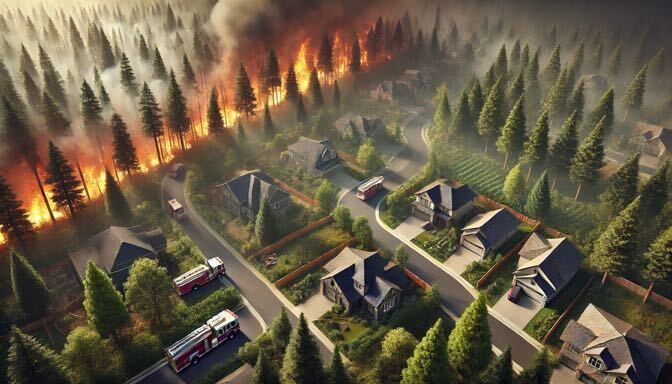In recent years, wildfires have evolved from a rural concern to a significant threat to urban areas. The expansion of cities into forested and vegetative regions, coupled with the increasing intensity of wildfires due to climate change, has placed urban communities at higher risk. As a result, wildfire preparedness is no longer optional—it is a necessity.
The Growing Threat
Wildfires are becoming more intense, widespread, and unpredictable. Factors such as prolonged droughts, high temperatures, and wind patterns make it easier for fires to spread quickly. Urban areas close to forests or grasslands are particularly vulnerable, but even cities miles away from active fires can suffer from poor air quality and ash fallout.
The 2020 wildfire season in California, for instance, saw over 4.2 million acres burned, with smoke impacting air quality across the United States. As wildfires encroach on suburban and urban zones, communities must act to mitigate risks and prepare for emergencies.
Defensible Space: A Crucial Buffer
One of the most effective ways to protect homes and businesses from wildfires is by creating defensible space. Defensible space refers to the area around a structure where vegetation and other flammable materials are managed to slow the spread of fire.
Key steps to establish defensible space include:
• Clearing Vegetation: Remove dry brush, dead trees, and other flammable materials from around your property.
• Pruning Trees: Trim branches at least 10 feet away from roofs and remove any branches close to power lines.
• Fire-Resistant Landscaping: Use non-flammable materials like gravel or stone and plant fire-resistant species such as succulents and hardwood trees.
Municipalities can also encourage defensible space practices by providing grants or incentives to homeowners and businesses.
Improved Air Quality Systems
Even if flames do not reach urban centers, the smoke from wildfires poses severe health risks. Smoke contains fine particulate matter (PM2.5), which can cause respiratory and cardiovascular problems.
To mitigate these effects:
• Upgrade HVAC Systems: Install high-efficiency filters (HEPA or MERV-13 rated) in office buildings and homes to reduce indoor air pollution.
• Use Air Purifiers: Portable air purifiers can help maintain breathable air in smaller spaces.
• Seal Gaps: Ensure doors, windows, and vents are sealed properly to prevent smoke from entering.
Cities can also set up community clean-air shelters equipped with advanced filtration systems to protect vulnerable populations during wildfire events.
Community-Wide Preparedness Plans
Wildfires can disrupt transportation, power supplies, and communication networks, leaving unprepared communities vulnerable. Local governments and organizations must work together to create comprehensive wildfire preparedness plans.
Key components of such plans include:
• Evacuation Routes: Map multiple evacuation routes and ensure they are clearly marked and accessible.
• Emergency Communication: Implement systems that provide real-time alerts via mobile apps, text messages, and public broadcast systems.
• Public Education: Host workshops and distribute materials that teach residents how to prepare emergency kits and what to do during a wildfire.
The Role of Technology
Advances in technology are aiding wildfire preparedness efforts. Satellite imagery and predictive models can provide early warnings, while apps like Watch Duty and Red Flag can keep residents informed about nearby fires.
Cities can also deploy drones for real-time monitoring and use geographic information systems (GIS) to identify high-risk areas and allocate resources effectively.
Individual and Collective Responsibility
Wildfire preparedness is not just the responsibility of governments and businesses—it requires individual action as well. Residents should:
• Develop and practice a family evacuation plan.
• Keep a go-bag with essentials like water, non-perishable food, medications, and important documents.
• Stay informed about fire risks and alerts through local and national services.
As wildfires become more frequent and intense, urban communities must adapt. Proactive measures like creating defensible spaces, improving air quality systems, and developing comprehensive preparedness plans can significantly reduce risks. By working together—residents, businesses, and governments alike—we can build resilient communities capable of withstanding the growing wildfire threat.
Preparedness today can mean survival tomorrow.





